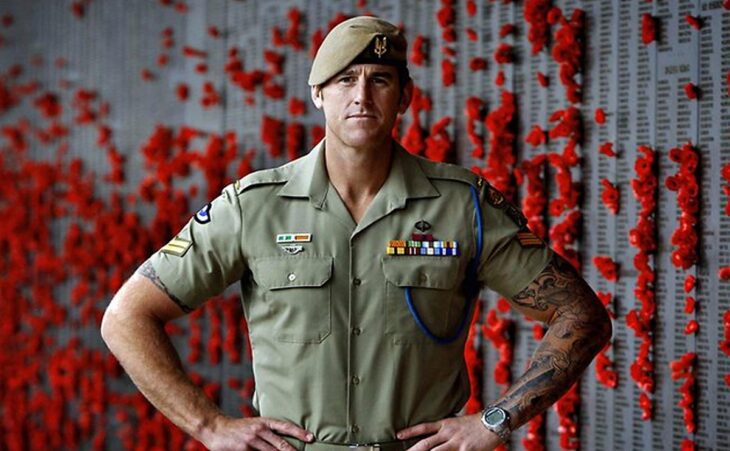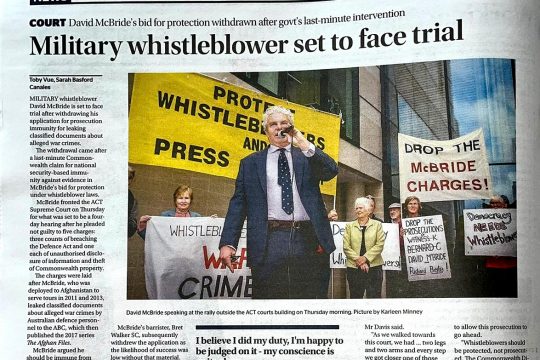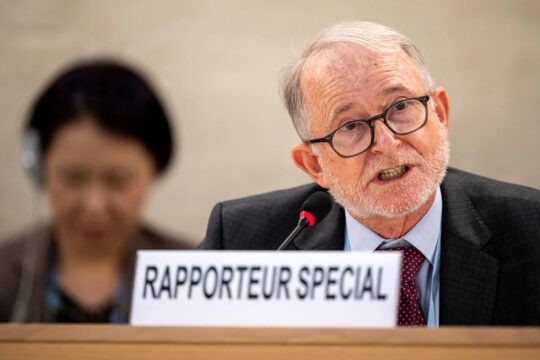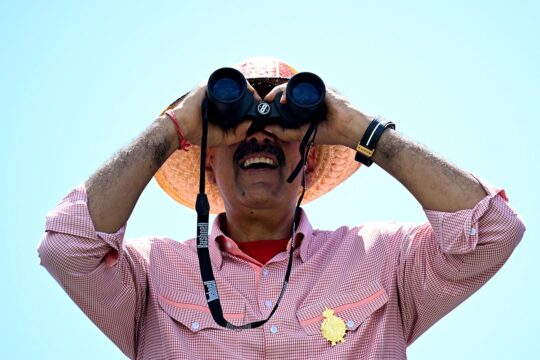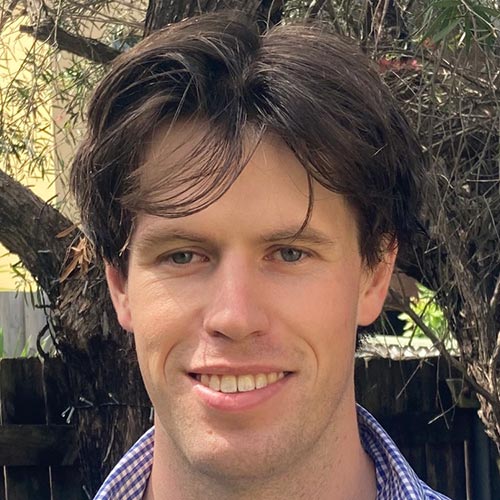As Ben Roberts-Smith lay stretched out, sunning himself on a Bali pool deck Justice Anthony Besanko of the Federal Court of Australia was putting the finishing touches on a 726 page judgment, published on Monday June 5, that would confirm Roberts-Smith’s fall from revered national hero to a “callous and inhumane” criminal, who “disgraced his country” by committing, on multiple occasions, the war crime of murder while deployed to Afghanistan with Australia’s special forces (SAS).
The proceedings, which were the equal longest in the Federal Court’s history, concerned allegations made in three newspapers in 2018 that Roberts-Smith had, among other things, kicked a unarmed Afghan civilian off a cliff, and procured a soldier under his command to shoot him; pressured an inexperienced special forces soldier to execute an elderly, unarmed Afghan in order to “blood the rookie”; and had killed an unarmed prisoner with a prosthetic leg by machine-gunning him from close range.
While the verdict was a civil judgment in a defamation trial, criminal jeopardy remains for Roberts-Smith and the witnesses whose actions in Afghanistan were given a public airing at trial. Justice Besanko found that the Victoria Cross recipient was motivated to lie at trial “to resist findings against him which may affect whether further action is taken against him,” and noted that “it is inherent in the finding of criminal conduct [at a civil trial] that that may increase the likelihood of the alleged actor being [criminally] charged.”
Highest degree for a defamation case
Roberts-Smith argued that the articles published by the journalists conveyed various defamatory imputations, including that he “committed murder” on numerous occasions within the meaning of the Geneva Conventions and Australia’s complementary legislation, authorised unlawful killings and “bashed” an unarmed civilian. It was further pleaded by his lawyers that the articles conveyed the imputation that Roberts-Smith “broke the moral and legal rules of military engagement and is therefore a criminal.”
Roberts-Smith sought aggravated damages, the removal of the articles from media’s websites and a permanent injunction restraining publication of the defamatory imputations, effectively gagging further reporting on war crimes allegations against the former soldier.
The newspapers defended the imputations on the basis that they were substantially true – a notoriously difficult defence to prove in Australian defamation law. The newspapers were required to prove on the balance of probabilities that “every material part” of the imputations were true. Given the gravity of the allegations, the degree of satisfaction required by the judge was high: “where potential criminality is involved… exactness of proof is required,” said Besanko.
“What is unusual in this case is not only did Roberts-Smith lead imputations of actual criminality rather than reasonable suspicion of criminality, it is also that the newspapers were able to establish the substantial truth of that conduct”, explains Professor David Rolph, of the University of Sydney.
“If you’re proving actual criminal conduct, as [the newspapers] managed to do, they have to set out to prove to Ben Roberts-Smith actually murdered people, actually was complicit in the murder of people, and actually committed war crimes. That’s much more forensically onerous than merely demonstrating that there is a reasonable suspicion of these things.”
That’s why, in ruling in favour of the newspapers, Justice Besanko made a finding that it was true that Roberts-Smith was a criminal who “broke the legal rules of military engagement” and committed multiple war crimes.
“Blooding the Rookie”
The civil judgment therefore includes a finding that war crimes were committed under Australian and international law.
On Easter Sunday 2009, Roberts-Smith and his troop were instructed to assault a compound code-named Whiskey 108. Persons 14 and 24 [the identities of SAS soldiers are protected] gave evidence for the newspapers that, in the lead up to the mission, they heard Person 5 (the troop commander and a close friend of Roberts-Smith) say in group settings that “we” were going to “blood the rookie,” referring to Person 4, a member Roberts-Smith’s troop.
After securing the compound, the soldiers discovered a tunnel in a courtyard. Justice Besanko accepted the evidence of the newspapers’ witnesses that two Afghan men emerged from the tunnel, surrendered and were placed under the control of the Australian troops. One man was elderly and the other had a prosthetic leg.
Person 24 gave evidence that, around this time, he saw Roberts-Smith emerge from the compound holding the elderly man. He heard Person 5 shout at Person 4 saying “get in here. Get in here now.” At this point, Roberts-Smith approached Person 41, who was searching a room, and asked to borrow his silencer. He continued:
“[Roberts-Smith] then walked down and grabbed the Afghan male by the scruff of the shirt, picked him up and marched him a couple of metres forward [so] he was in front of Person 4. He then kicked him in the back of the legs behind the knees until he was kneeling down in front of Person 4. He pointed…to the Afghani [sic] and said to Person 4, ‘Shoot him’.”
After averting his gaze, Person 41 looked back to see Person 4 standing “in a bit of a state of shock,” with “a dead Afghan male at his feet.”
Roberts-Smith’s account “highly improbable”
Further, Person 41 told the court that, after leaving the compound to search another area, he observed Roberts-Smith walking towards him. He had his machine-gun held up with his right arm and was “frog-marching [another] Afghan by the scruff of his neck with his left arm.” This was the man with the prosthetic leg.
“[BRS] then proceeded to throw the Afghan male down onto the ground. The Afghan male landed on his back. [BRS] then reached down, grabbed him by the shoulder, flipped him over onto his stomach, and then I observed him lower his machine gun and shoot approximately three to five rounds into the back of the Afghan male. After he had done that, he looked up and saw me standing there, and he looked at me and said, ‘Are we all cool? Are we good?’ And I just replied, ‘Yeah, mate, no worries.’”
The man’s prosthetic leg later found its way to the SAS base, where it was mounted and used as a drinking vessel.
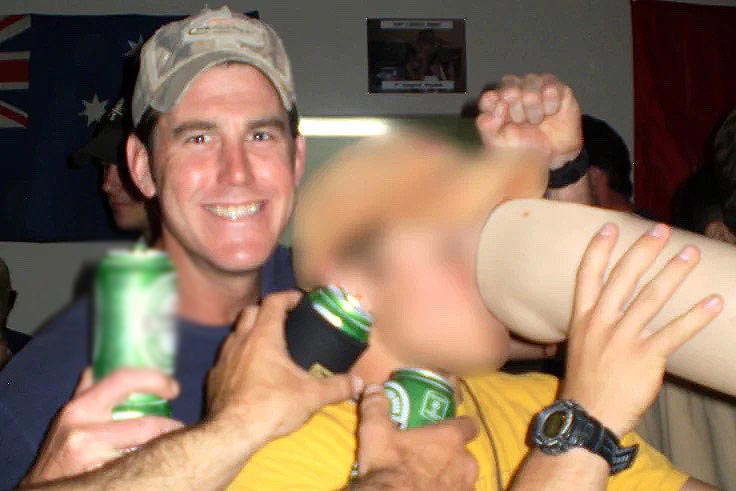
Justice Besanko found that the version of events led by the newspapers and described above was truthful, and was highly critical of the evidence of Roberts-Smith and his witnesses. Through a loan from the newspapers’ media rival Kerry Stokes, Roberts-Smith was paying the legal fees of Persons 5, 29 and 35, who all gave evidence supporting his contradictory version of events. Besanko found that Roberts-Smith’s account was “highly improbable,” and he had motives to lie, including “to resist findings against him which may affect whether further action is taken against him.”
The murder of Ali Jan
Another event is documented in detail in the ruling. On September 11 2012, Roberts-Smith participated in a mission to the village of Darwan, following up on intelligence that a rogue Afghan soldier was or had been in the village.
Towards the end of the mission, Roberts-Smith and others were clearing compounds in the area. In one, they found three fighting-age males, who were handcuffed and rendered hors de combat. One of the men was named Ali Jan.
An Afghan witness, Mohammed Hanifa, told the court from a secure location in Kabul that he was taken outside with Ali Jan and questioned by the Australians. He recalled being punched and kicked by “the big soldier” while pressed up against a wall. Another Afghan witness, Shahzada Faith described seeing “the big soldier” make Ali Jan stand up and walk over to the edge of an escarpment overlooking a dry creek bed.
Person 4 told the court that Ali Jan was made to stand with his back towards the large slope, and was held by Person 11. At this point, Roberts-Smith “walked forward and kicked [Ali Jan] in the chest… [he] was catapulted backwards and fell down the slope.” Person 4 saw Ali Jan’s face strike a rock on the way down, causing him to lose a number of teeth. After Ali Jan was brought back to his feet, he then saw Person 11 have a quick conversation with Roberts-Smith. After hearing shots ring out, he turned back to see Person 11 with his rifle raised next to a dead body.
When Person 4 next saw the body, the handcuffs had been removed and a radio placed on the body in an effort to indicate that Ali Jan had been a combatant. It was photographed in this state and used to support an official report of events agreed upon by the soldiers after the mission.
As with the incidents at Whiskey 108, Justice Besanko found that Roberts-Smith’s case contained “a number of improbabilities” and that he “discussed his evidence at length” with Person 11, his only supporting witness, prior to the trial.
The newspapers were also able to prove that Roberts-Smith committed another murder in an October 2012 mission to the village of Chinartu. The court found that “through an interpreter [BRS] ordered Person 12 to shoot an Afghan male who was under detention … Roberts-Smith was complicit in and responsible for murder.”
Ongoing war crimes reckoning
The defamation judgment marks the end of the beginning of Australia’s war crimes reckoning. The media reports which first brought allegations of war crimes into the public consciousness have been proven largely to be true, outing one of Australia’s most decorated soldiers as a war criminal and revealing the complicity of other members of the SAS.
Professor Melanie O’Brien of the University of Western Australia says “that’s what makes this case so interesting, because [war crimes being contested in a civil trial] is something that hasn’t been seen before….it’s certainly not the usual way to go about dealing with war crimes.”
However, as the usually sensitive details of conflict incidents received a public and dramatic open court hearing, the official war crimes investigation continues. Representatives of the Federal Police and the Office of the Special Investigator (OSI) sat through the entirety of the trial, and it was revealed during the hearings that Roberts-Smith was being investigated by the OSI.
While the evidence given at the civil trial will not be directly admissible in criminal court, by launching the defamation case, Roberts-Smith has locked himself into a version of events found by a judge to be not credible, and the result of collusion. Efforts to conceal evidence and intimidate witnesses may also be led as evidence of consciousness of guilt. Indeed, as O’Brien says, “the first thing we may see is charges laid for threatening witnesses.”
The investigation will continue outside of the public eye, but the very public civil case effectively implicates a number of other former soldiers who gave evidence. The OSI told the Senate in May that it was “currently progressing approximately 40 matters.”


